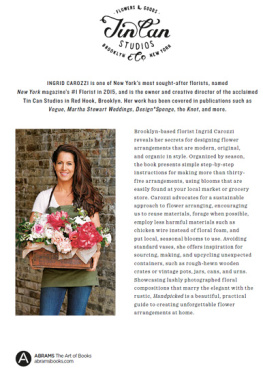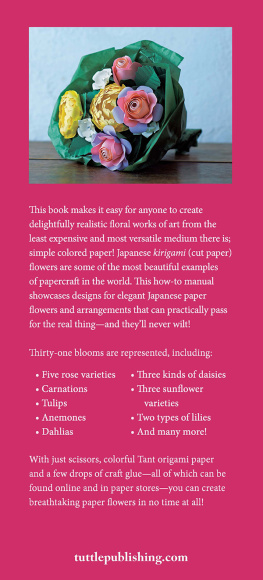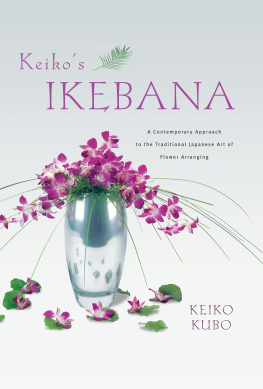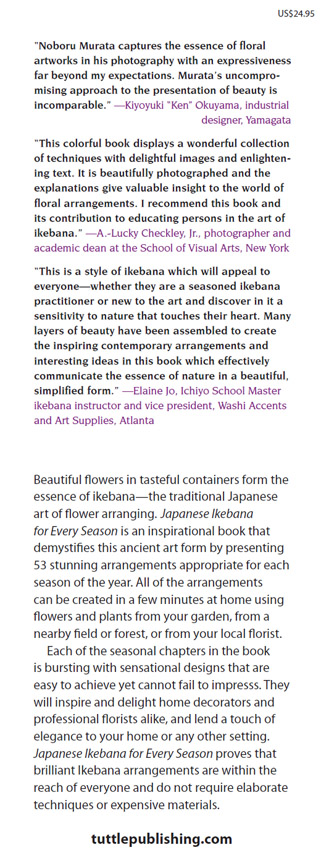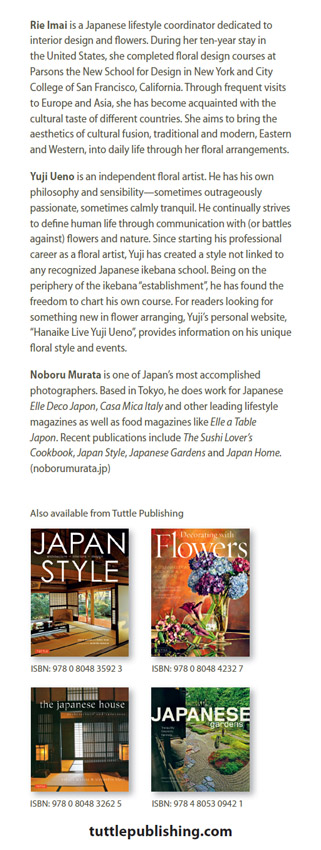acknowledgments
For copyediting and English support, we received tremendous assistance from Kathleen Adair. She is a Master instructor of modern ikebana and the founding member of an independent group that studies with various ikebana artists and headmasters.
We would also like to extend our heartfelt thanks to the following people without whom this book could not have been realized.
PUBLISHING
Eric Oey, June Chong and Chan Sow Yun (all from Tuttle Publishing)
DESIGN
Masakazu Fujii (F Design Office), Natsuho Sugawa
PHOTOGRAPHS
Tomoko Osada
ARTISTIC ADVICE
Kaoru Yamamoto
OTHERS WHO HAVE PROVIDED ASSISTANCE, SUPPORT AND INSPIRATION
Miki Arai, Seika Adachi, Naoko Fujimura, Kaori Imaizumi, Serge Coing, Kazuyo Omata, Etsuko Nagasawa, Kaz Imai
PROCUREMENT OF MATERIALS AND FACILITIES FOR PHOTO SHOOTING
Tokyomatsuya Inc. (Tokyo)
Ozuwashi (Tokyo)
Benandsebastian (Copenhagen)
Tistou Co., Ltd (Tokyo)
Jikonka (Tokyo)
Studio R (Tokyo)
afterword
A few years ago, I rediscovered the charm of ikebana when I stumbled across a flower arrangement in a small gallery in Tokyo. The arrangement, graceful and dignified, simple but strong, made a huge impression on me and has stayed in my mind ever since. The arrangement did not use any special devices or complicated techniques. The flowers were not special or rare, and the container was not one that was typically used in ikebana. But I felt a connection with the arrangement that transcended its beauty and power to encompass a much larger existencethe whole universe and the world of nature.
This was my first electrifying encounter with the work of Yuji Ueno, a flower artist living in Tokyo. When he was in his twenties, Yuji practiced ikebana at an established school and mastered the conventional techniques. But in a radical departure from his training in traditional ikebana, he now expresses contemporary trends in Japan through his inventive and original floral displays. My encounter with Yuji's ikebana in the small gallery in Tokyo was undoubtedly the starting point for this book. It is what motivated me to convey my delightful experience and admiration for his work to a much wider audience, both at home and abroad.
Yujis floral arrangements, all specially created for this book, are enhanced by the outstanding photographs of magical master photographer Noboru Murata. All taken in natural light, the photographs capture the full impact and spirit of Yujis distinctive creations. The collaboration between Yuji Ueno and Noboru Murata has resulted in a publication on modern Japanese-style flower arranging that is sure to delight and inspire readers to replicate the arrangements or to use them as a springboard for their own creations. The arrangements are within the reach of everyone and will not fail to impress whoever sees them.
In March 2011, the Great East Japan Earthquake and tsunami hit Japan. The horrific events and subsequent efforts to recover from them demonstrated the tenacity, resilience and spirituality of the Japanese people. The floral works displayed in this book were all made after these tragic events and during the ongoing recovery. They, too, reflect the Japanese mentality, the strong spirituality that is at the heart of ikebana, whether consciously or not. It is hoped that ikebana, which is not merely a simple flower decoration technique, will inspire people in Japan and in other countries to take an interest in this new, fresh type of ikebana and make it a satisfying and integral part of their lives. Rie Imai
CONTENTS






Published by Tuttle Publishing, an imprint of Periplus Editions (HK) Ltd
www.tuttlepublishing.com
Copyright 2013 Periplus Editions (HK) Ltd
All rights reserved. No part of this publication may be reproduced or utilized in any form or by any means, electronic or mechanical, including photocopying, recording, or by any information storage and retrieval system, without prior written permission from the publisher.
ISBN: 978-1-4629-1428-9 (ebook)
Distributed by
North America, Latin America & Europe
Tuttle Publishing
364 Innovation Drive, North Clarendon, VT 05759-9436 USA
Tel: 1 (802) 773-8930; Fax: 1 (802) 773-6993
info@tuttlepublishing.com
www.tuttlepublishing.com
Japan
Tuttle Publishing
Yaekari Building, 3rd Floor
5-4-12 Osaki, Shinagawa-ku, Tokyo 141 0032
Tel: (81) 3 5437-0171; Fax: (81) 3 5437-0755
sales@tuttle.co.jp
www.tuttle.co.jp
Asia Pacific
Berkeley Books Pte Ltd
61 Tai Seng Avenue #02-12, Singapore 534167
Tel: (65) 6280-1330; Fax: (65) 6280-6290
inquiries@periplus.com.sg
www.periplus.com
15 14 13 10 9 8 7 6 5 4 3 2 1
Printed in Singapore 1310CP
TUTTLE PUBLISHING is a registered trademark of Tuttle Publishing, a division of Periplus Editions (HK) Ltd.


Rie Imai and Yuji Ueno
Photography by Noboru Murata
TUTTLE Publishing
Tokyo | Rutland, Vermont | Singapore
autumn
After the hot and often humid summer, when plants spend all their energy growing, autumn offers respite from the heat and supplies abundant fruits to savor. The suns glare slowly softens to a honey-colored light and shadows grow longer and longer. A change of radiance causes the color tones we see in the moderate autumn sunlight to appear deeper and more muted.
Autumn is the season to enjoy a feast of color. Mountains flare with turning red and yellow leaves and orchards and fields bear fruits and vegetables of multiple colors. In Japan, we pray for a fertile harvest and offer flowers to the gods that are believed to exist in all living things. People appreciate the plentiful gifts from nature with a thanksgiving celebration meal, a common event all over the world.
Create simple modern ikebana using the floral materials of the harvest time. Autumn colors of red, orange and yellow express warmth and comfort as the season cools. Your home interior will be enriched with Japanese-style arrangements to accompany feelings of gratitude. Flexible and less restrained flower arrangements are more suited to this season. Cascading or hanging arrangements, rather than vertical ones, may be appreciated in terms of their structure. Typical materials used in this season include branches heavy with berries or fruit, wispy flowers and tinted leaves that can be found in gardens and woodlands.


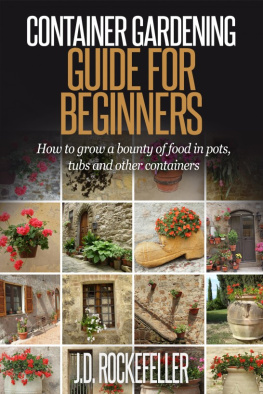
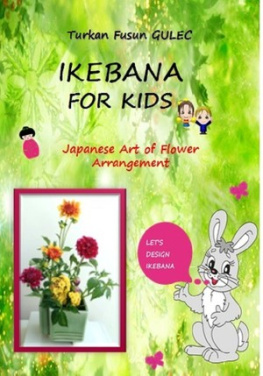

![Shinichi Nagatsuka [永塚慎] - Modern Japanese Ikebana: Elegant Flower Arrangements for Your Home](/uploads/posts/book/320284/thumbs/shinichi-nagatsuka-modern-japanese.jpg)
![Shinichi Nagatsuka [永塚慎] - Easy Ikebana: 30 Beautiful Flower Arrangements You Can Make in Three Simple Steps](/uploads/posts/book/306395/thumbs/shinichi-nagatsuka-easy-ikebana-30.jpg)


